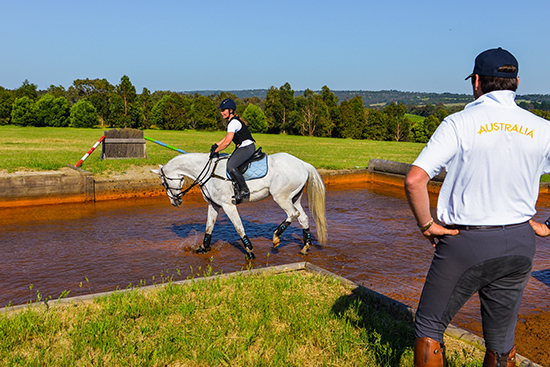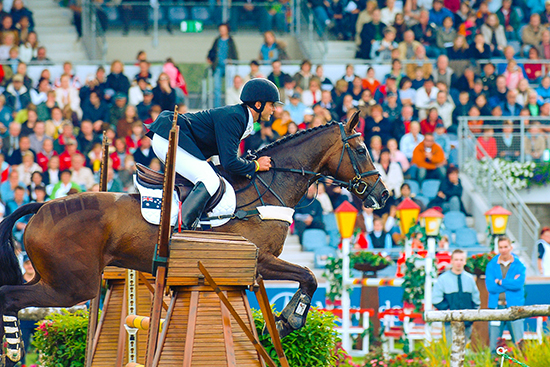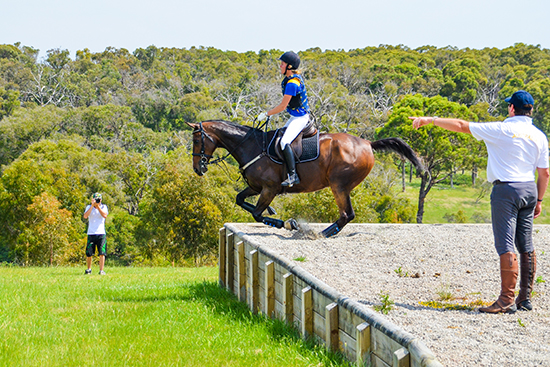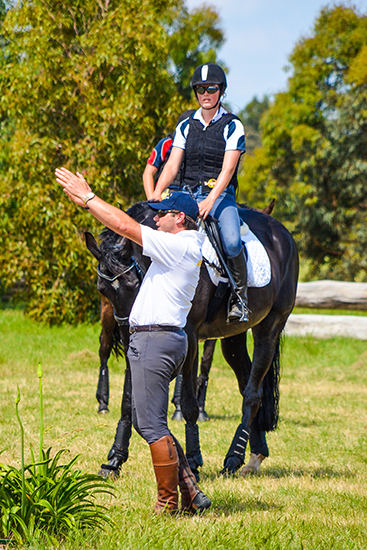 Story: Chris Hector & Photos: Michelle Nicholls and Roz Neave
Story: Chris Hector & Photos: Michelle Nicholls and Roz Neave
It has been a dramatic couple of months for Australian eventer, Clayton Fredericks. Along with the decision to re-locate to Florida, Clayton has called an end to his career as an international eventing rider, and taken up the position of Coach to the Canadian Eventing Team.
Still, Clayton found time to visit family and friends in Australia, and conduct a clinic at Fairhurst on the Mornington Peninsula. After Clayton finished his training session, he looked back at where he had come from, and where he was headed…’ in an interview with Chris Hector:
You made the transition from being a showie to being an international eventer, who or what were the important influences in that transition? I guess what I am really getting at, is how much can you teach and how much is natural…
“I think because I did come from a showing background, I hadn’t really jumped except at Pony Club, so my learning of how to get the horses to go, how to see a stride even, came very much from bashing it out myself in the field. I had lots of lessons – don’t get me wrong – and I’ve always picked up lots of different things from a huge host of Aussie trainers and more recently European trainers, but I think ultimately with horses, there is no right or wrong. There is only what you do, and how you treat the horses and get them to perform and do what we want them to do.”
“I suppose I learnt a lot from the showing days, not only how to get a horse to turn on when you need it, but also to switch off a little. It is very important as a rider that you can train and produce the horses in a soft and relaxed way, and get your message through to the horse. As a trainer, it is important that you can verbalise what you feel, because ‘feeling’ in riding is paramount. They say you can’t teach feeling – ok you can’t completely teach the feel, what you can do is give riders an experience of the way it should feel, then it is up to them.”
“Whenever you come to jump a fence – any fence – the horses have to be able to look at a fence and they have a responsibility to take care of themselves, to make an adjustment in stride or whatever is necessary. As a rider comes round the corner, and especially coming to a narrow fence, generally the riders feel they have to ride the horse over that skinny jump, they are using leg aids, they are using hand aids, they are almost wrestling with the horse, and the horse’s mind is not looking forward, not focusing on the fence, not thinking about what is ahead of them. Their ears are a dead give away, nine times out of ten, they are backwards, and they suddenly see the narrow fence, they are surprised that it is in front of them – bang – they jump out to the side.”
“You need a certain feel to be able to present a horse in front of you so that they see the fence as well, while you are still arriving at that fence in a good balance, a good rhythm, correct pace for the fence. You’ve got to combine all those qualities in a way that the horse is still able to see the fence, that takes a lot of feel.”
“People need to realise that when they discuss problems, they say, ‘use more leg, or use more hand, come this line or that’, but the reality is, if the rider just stays in the middle of the horse, and does less, quite often the horse will start to look for the fence and take the rider. What I try to do in my clinics is get rid of some of the riders’ anxiety, allow them to relax and focus on staying in the centre of the horse, having a situation where the horse is completely in front of your leg, but also submissive in the contact – between leg and hand – while maintaining all that, you allow the horse the freedom to look and judge and take a bit of responsibility for themselves about jumping the fence.”
Where was it? You were riding Ben through the water, and you were all over the shop, and the horse just kept focusing on the jump…
“It was the World Cup Final in Malmo, they had a water jump – a big log jumping in, a sizeable drop, three or four strides to a very skinny triple brush. As he jumped in, he whacked it with his stifle, the saddle hit me in the butt, I’m thrown forward right up around his neck, I was completely out of the saddle, practically biting his ear, he’d gone down from my weight, flicked his head up, thrown me back in the saddle, his ears are pricked to the jump and he’s gone straight over the arrowhead. I’ll never forget it, the crowd gave a huge cheer because I was leading after the dressage and they thought the leader was going to be in the drink… and Ben just looked for the jump and kept coming.”
“Okay he was a super horse, basically if you pointed him in the right direction, he’d try to jump it, but it certainly helped that he’d been trained along the lines of teaching the horse to take the rider. Even the best riders in the world don’t always get the right stride or the right line. You’d like to think you get 90% but even the best in the world make mistakes over 10% of the course, and at that point, that is really where the training kicks in. That is where the horse has to help you out, and if they are looking to take you to the jump, they do help you out.”
“I think this is part of selection – when you select horses to go eventing, you have to be careful. I’ve had very few horses that have been established and up-and-running before they come to me. From a rider’s point of view, you could say it is a luxury that I’ve had horses as four, five or six-year-olds, and I’ve done all the training with them. It’s nice to have taken a horse right from the base all the way through. Having said that, it is the mind of the horse that we are selecting. Yes, you want a good mover, yes, you want a super jumper, but one of the things I look for most in young horses is the trainability, the will to please.”
How do you assess that – you have fronted some muddy yard in Ireland or a picturesque Haras in France – and there is a rank four-year-old in the box?
“You’ve got to look for the traits, when the horse is coming to a fence, you look at what its face is doing, look where the ears are. Are the ears pricked? Do they jump the fence in a relaxed style? You certainly don’t look for horses that are running through the jumps, you don’t want that one with the eyes rolling in the back of its head. Aggressive horses with their ears back in the stable can still be quite handy event horses. They don’t all have to be soft, loving horses. In fact some of my best ones started off as quite aggressive horses. I don’t really know the psychology of that, but over time, they definitely become more friends.”
“I do speak very emotionally about my horses because most of them I’ve had for at least three or four years, five years, sometimes ten years…”
You were saying that your time in the hack ring taught you about presenting a show – eventing dressage has moved a long way in that direction, once it was just hit the markers and keep it neat, but the eventing dressage judges want more than that now…
“I think what the showing taught was that you had one shot at a work out and that work out had to startle the judge, or emotionally move the judge, to choose you as the best, you had to be perfect and right then in the moment. You had two or three minutes to do that. So it was similar to the dressage at an event, you’ve got to be in that arena, at a moment, and you’ve got to perform. For a lot of riders the downfall is that they can produce lovely work at home, but right there in the arena on the day, can’t do it. Some people find learning that trick very hard, it’s a lot of understanding of the horse but it also comes down to the horse’s attitude and its rideability. Even though event horses tend to get more difficult as they go up the grades because they are waiting for the heightened adrenalin buzz, whether it’s later that day or the following day.”
Is there the same psychological dimension to producing the big cross country run on the right day?
“Yes, and again, I think it is important that you know how to control the tension and be able to relax the horses as well. A lot of the problems that come cross country, come because the horses aren’t focused or attentive. They have let the adrenalin skew their brain. Benalong Time taught me a lot. If you started the cross country at the wrong moment with him, he could be a real bad ride – he would bolt, he just wouldn’t listen. He was never a horse to be stirred up, he was one to calm down. I’d ride him quite often twice before he went cross country. I wouldn’t knacker him with heaps and heaps of work, but I would certainly do a lot of relaxing work so that when it came to the cross country, it wasn’t such a big deal to him.”
“With him I knew when he needed to urinate – I think there are a lot of horses that can’t concentrate because they want to pee. I know I can’t concentrate if I need a pee. But he was bad, you had to take him straight back to the box, let him have a pee, and he would come out a different horse. Even in training at home you had to be careful with him.”
And the rider? There are some who flourish at a Games or a WEG, and some who die…
“Exactly. It is a completely different ball game when you get to a Championship. Going and competing at a Badminton or a Burghley is one thing, because you just have to look after yourself, you don’t have to worry about anything other than your horse and what you are doing. Get into a Championship situation and there’s coaches for all phases, vets, other people in the team, other riders – even your wife in the team – there’s a lot of different pressures, and you need methods to cope with that.”
“It is no secret that I was lucky enough to have the McCauleys who backed me for a long time, and Peta McCauley is a psychologist, and she helped me a lot. We did a lot of meditation… for a long time I never realised how nervous I was. I always thought I was a pretty cool customer, but you’ve got to be able to realise that you do actually get quite nervous about competing. Peta gave me a lot of techniques to handle that, mainly the meditation. I still do quite regular meditation, probably not as regular as I should, but whenever I am feeling a bit stressed or pressured, I turn to meditation to help relax. It is a very handy tool and probably under-used by a lot of riders.”
You’ve ridden in Australian teams under very different regimes – it was a lot different under the leadership of Wayne Roycroft to the current team with Prue Barrett. Under Wayne the coaches were very hands on, with Prudence she sees herself more as a coordinator and is happy for riders to access their own coaches, what kind of a coach are you going to be with the Canadians?
“Sadly we don’t really have the funding to have too many outside coaches. I’ve had quite a lot of training with the riders and already have a good rapport with some of them and they seem to have enjoyed what I am bringing to them – but I am not one to think that I know everything, and I am quite happy to have other inputs from the riders’ personal coaches. I think I see myself more as the manager and mentor type who can bring all the phases together – you have got to have an holistic approach to horses. One coach is not going to make the big difference. You have to have everyone happy, working in a good environment. You have to have the horses’ health right with the vets, the physio needs to be in place, you need to take care of the mental health of the horses, the mental health of the riders. There is so much to it, and I suppose if I bring anything, I bring a lot of experience of managing all that. To be successful in our sport these days, it is not just about being a good rider, there are plenty of good riders out there, you have to have the ability to communicate with people. You need to be able to manage a big team and keep all those people interested in what you are doing and loyal and working together. Anyone who has had experience with running their own business in equestrian, potentially has the ability to be a good coach.”
Like Clayton…
 This article first appeared in the March 2013 issue of THM.
This article first appeared in the March 2013 issue of THM.





Enjoyed the read. Clayton is very grounded and has his finger on the pulse of eventing. He has some good advice for those who aim for the highest levels!